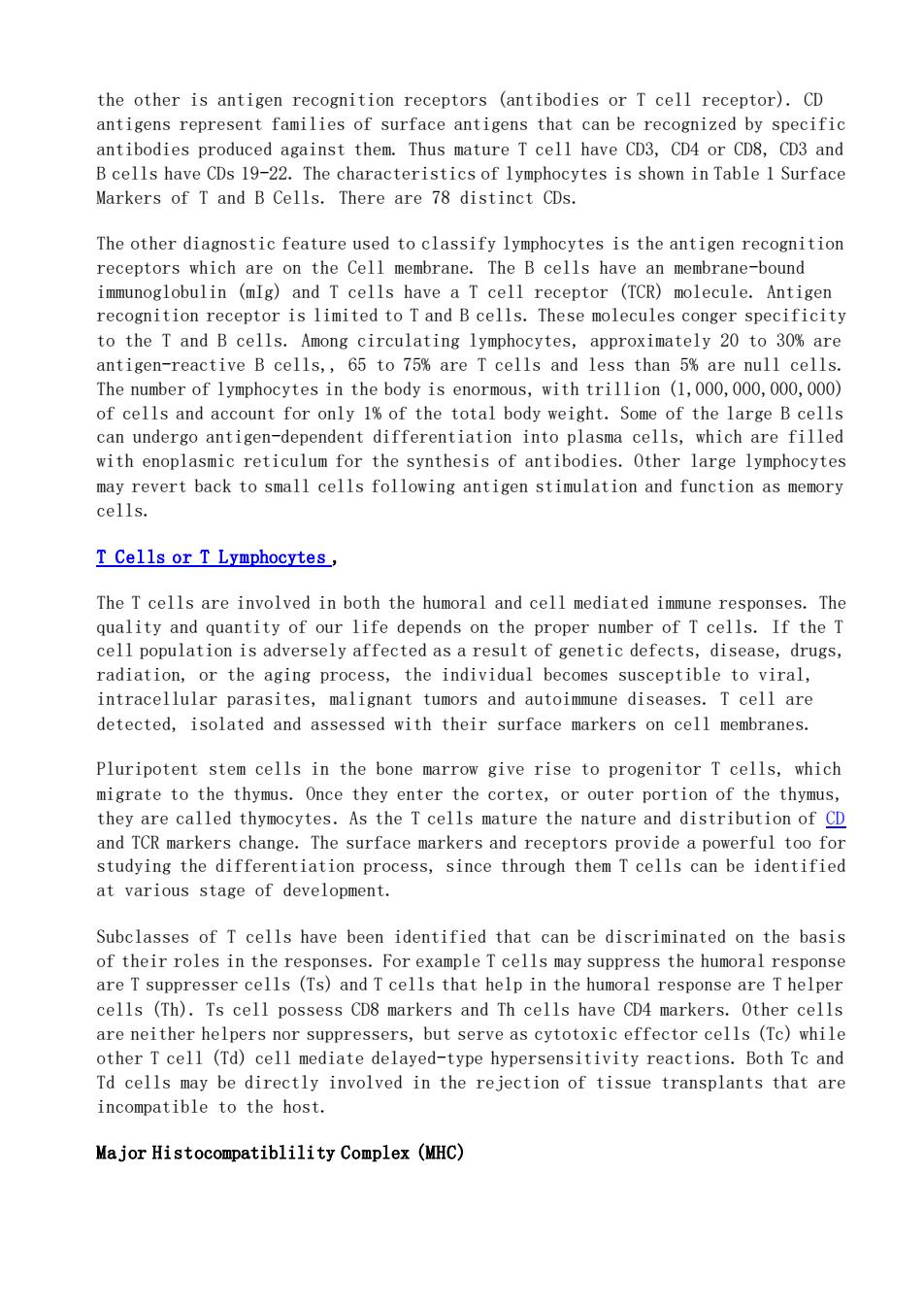正在加载图片...

the other is antigen recognition receptors (antibodies or T cell receptor).CD antigens represent families of surface antigens that can be recognized by specific roduced against them.Thus mature T cell have CD3,CD4 or CD8,CD3 and B cells have CDs 19 9-2 The characteristics of lymphocytes is shown in Table 1 Surface Markers of T and B Cells.There are 78 distinct CDs. The other diagnostic feature used to classify lymphocytes is the antigen recognition receptors which are on the Cell membrane.The B cells have an membrane-bound immunoglobulin (mIg)and T cells have a T cell receptor (TCR)molecule.Antiger gnition receptor is limited to T and B cells.These molecule specificity to the T and B cells.Among circulating lymphocytes,approximately 20 to 30%are antigen-reactive B cells,,65 to 75%are T cells and less than 5%are null cells The number of lymphocytes in the body is enormous,with trillion (1,000,000,000,000) of cells and account for only 1%of the total body weight.Some of the large B cells can undergo antigen n-dependent differentiation into plasma cells,which re filled with enoplasmic reticulum for the synthesis of antibodies.Other large lymphocytes may revert back to small cells following antigen stimulation and function as memory cells. T Cells or T Lymphocytes. The T cells are involved in both the humoral and cell mediated immune responses.The e proper number cells.If the I as a result of genetic defects,disease,drugs radiation,or the aging process,the individual becomes susceptible to viral, intracellular parasites,malignant tumors and autoimmune diseases.T cell are detected,isolated and assessed with their surface markers on cell membranes. Pluripotent stem cells in the bone marrow give rise to progenitor T cells,which migrate to the thymus.Once they enter the cortex, or outer portion of the thymus, they are called thymocytes.As the T cells mature the nature and distribution of CD and TCR markers change.The surface markers and receptors provide a powerful too for studying the differentiation process,since through them T cells can be identified at various stage of development. Subclasses of T cells have been identified that can be discriminated on the basis of their roles in th responses For may suppress the humoral response are T suppresser cells(Ts)and T cells that help in the humoral response are T helper cells (Th).Ts cell possess CD8 markers and Th cells have CD4 markers.Other cells are neither helpers nor suppressers,but serve as cytotoxic effector cells (Tc)while delayed-type hypersens sitivity reactions.Both Tc and Td cells may be directly involved in the rejection of tissue transplants that are incompatible to the host. Major Histocompatiblility Complex (MHC)the other is antigen recognition receptors (antibodies or T cell receptor). CD antigens represent families of surface antigens that can be recognized by specific antibodies produced against them. Thus mature T cell have CD3, CD4 or CD8, CD3 and B cells have CDs 19-22. The characteristics of lymphocytes is shown in Table 1 Surface Markers of T and B Cells. There are 78 distinct CDs. The other diagnostic feature used to classify lymphocytes is the antigen recognition receptors which are on the Cell membrane. The B cells have an membrane-bound immunoglobulin (mIg) and T cells have a T cell receptor (TCR) molecule. Antigen recognition receptor is limited to T and B cells. These molecules conger specificity to the T and B cells. Among circulating lymphocytes, approximately 20 to 30% are antigen-reactive B cells,, 65 to 75% are T cells and less than 5% are null cells. The number of lymphocytes in the body is enormous, with trillion (1,000,000,000,000) of cells and account for only 1% of the total body weight. Some of the large B cells can undergo antigen-dependent differentiation into plasma cells, which are filled with enoplasmic reticulum for the synthesis of antibodies. Other large lymphocytes may revert back to small cells following antigen stimulation and function as memory cells. T Cells or T Lymphocytes , The T cells are involved in both the humoral and cell mediated immune responses. The quality and quantity of our life depends on the proper number of T cells. If the T cell population is adversely affected as a result of genetic defects, disease, drugs, radiation, or the aging process, the individual becomes susceptible to viral, intracellular parasites, malignant tumors and autoimmune diseases. T cell are detected, isolated and assessed with their surface markers on cell membranes. Pluripotent stem cells in the bone marrow give rise to progenitor T cells, which migrate to the thymus. Once they enter the cortex, or outer portion of the thymus, they are called thymocytes. As the T cells mature the nature and distribution of CD and TCR markers change. The surface markers and receptors provide a powerful too for studying the differentiation process, since through them T cells can be identified at various stage of development. Subclasses of T cells have been identified that can be discriminated on the basis of their roles in the responses. For example T cells may suppress the humoral response are T suppresser cells (Ts) and T cells that help in the humoral response are T helper cells (Th). Ts cell possess CD8 markers and Th cells have CD4 markers. Other cells are neither helpers nor suppressers, but serve as cytotoxic effector cells (Tc) while other T cell (Td) cell mediate delayed-type hypersensitivity reactions. Both Tc and Td cells may be directly involved in the rejection of tissue transplants that are incompatible to the host. Major Histocompatiblility Complex (MHC)